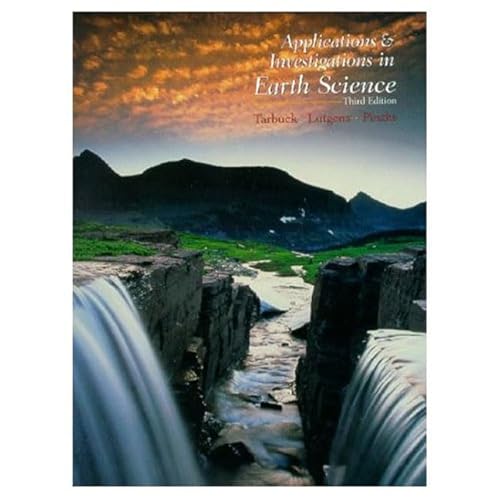Items related to Applications and Investigations in Earth Science (3rd...

Synopsis
This manual provides a comprehensive, versatile, and adaptable collection of 22 self-contained laboratories that examine the basic principles and concepts of geology, metrology, oceanography, and astronomy. Goes beyond the traditional exercises that examine measurements, mineral, rocks, latitude and longitude, topographic maps, Earth-sun relations, etc. For anyone interested in geology or geography.
"synopsis" may belong to another edition of this title.
From the Back Cover
This manual provides a comprehensive, versatile, and adaptable collection of 22 self-contained laboratories that examine the basic principles and concepts of geology, metrology, oceanography, and astronomy. Goes beyond the traditional exercises that examine measurements, mineral, rocks, latitude and longitude, topographic maps, Earth-sun relations, etc. For anyone interested in geology or geography.
"About this title" may belong to another edition of this title.
US$ 3.75 shipping within U.S.A.
Destination, rates & speedsSearch results for Applications and Investigations in Earth Science (3rd...
Applications and Investigations in Earth Science (3rd Edition)
Seller: HPB-Red, Dallas, TX, U.S.A.
spiral_bound. Condition: Good. Tasa, Dennis (illustrator). Connecting readers with great books since 1972! Used textbooks may not include companion materials such as access codes, etc. May have some wear or writing/highlighting. We ship orders daily and Customer Service is our top priority! Seller Inventory # S_377073499
Quantity: 1 available
Applications and Investigations in Earth Science
Seller: ThriftBooks-Dallas, Dallas, TX, U.S.A.
Spiral-bound. Condition: Fair. No Jacket. Tasa, Dennis (illustrator). Readable copy. Pages may have considerable notes/highlighting. ~ ThriftBooks: Read More, Spend Less 2.3. Seller Inventory # G0130112887I5N00
Quantity: 1 available
Applications And Investigations In Earth Science - Problem Solving And Program Design
Seller: Romtrade Corp., STERLING HEIGHTS, MI, U.S.A.
Condition: New. Tasa, Dennis (illustrator). This is a Brand-new US Edition. This Item may be shipped from US or any other country as we have multiple locations worldwide. Seller Inventory # ABNR-118991
Quantity: 1 available
Applications And Investigations In Earth Science - Problem Solving And Program Design
Seller: Basi6 International, Irving, TX, U.S.A.
Condition: Brand New. Tasa, Dennis (illustrator). New. US edition. Excellent Customer Service. Seller Inventory # ABEJUNE24-59197
Quantity: 1 available
Applications and Investigations in Earth Science (3rd Edition)
Seller: ALLBOOKS1, Direk, SA, Australia
Tasa, Dennis (illustrator). Seller Inventory # SHUB59197
Quantity: 1 available
Applications And Investigations In Earth Science
Seller: Books Puddle, New York, NY, U.S.A.
Condition: Used. Tasa, Dennis (illustrator). pp. 353 3rd Edition. Seller Inventory # 263113609
Quantity: 1 available
Applications And Investigations In Earth Science
Seller: Majestic Books, Hounslow, United Kingdom
Condition: Used. Tasa, Dennis (illustrator). pp. 353. Seller Inventory # 5782870
Quantity: 1 available
Applications And Investigations In Earth Science
Seller: Biblios, Frankfurt am main, HESSE, Germany
Condition: Used. Tasa, Dennis (illustrator). pp. 353. Seller Inventory # 183113603
Quantity: 1 available
Applications and Investigations in Earth Science (3rd Edition)
Seller: Mispah books, Redhill, SURRE, United Kingdom
Spiral-bound. Condition: Like New. Tasa, Dennis (illustrator). Like New. book. Seller Inventory # ERICA75801301128875
Quantity: 1 available

